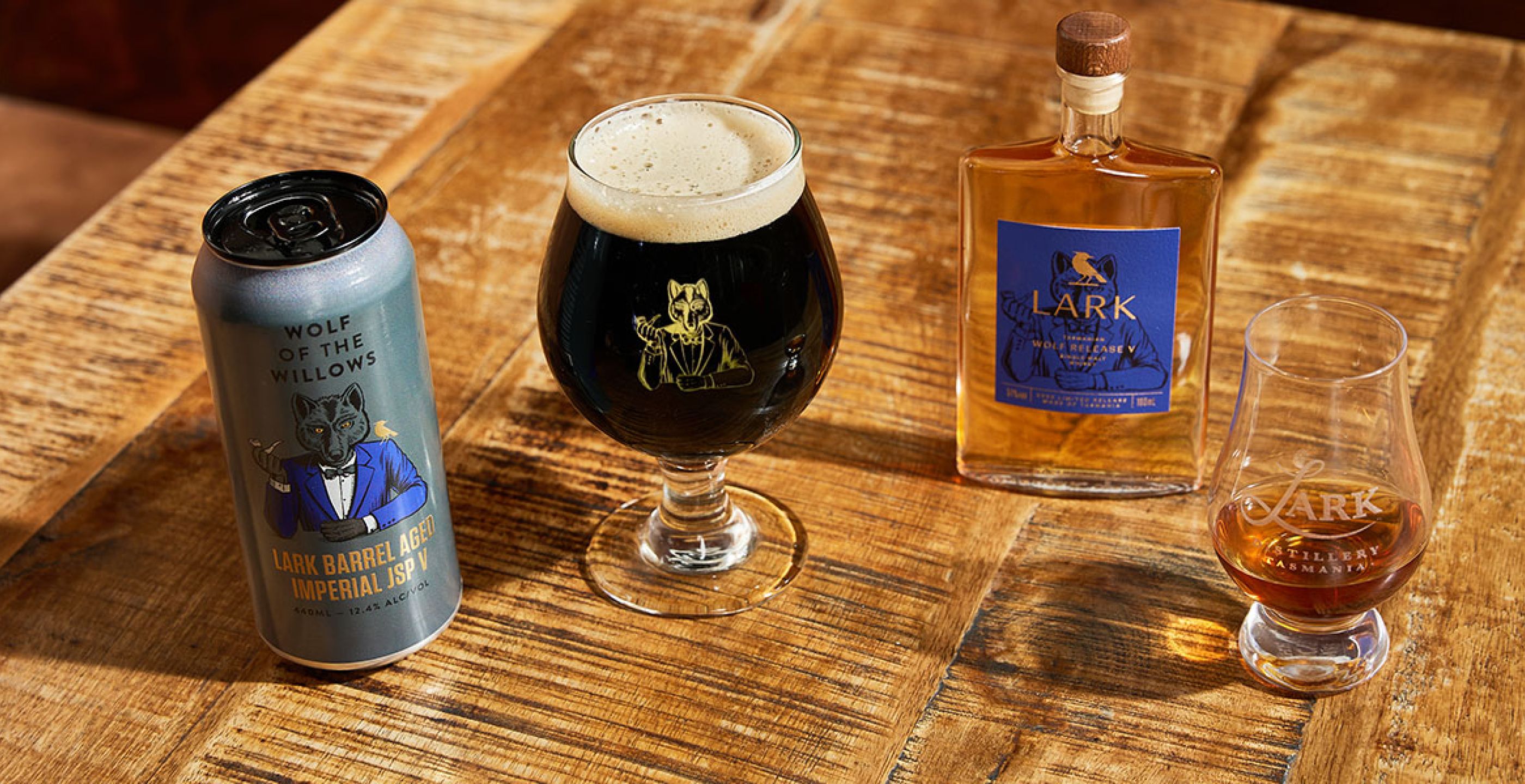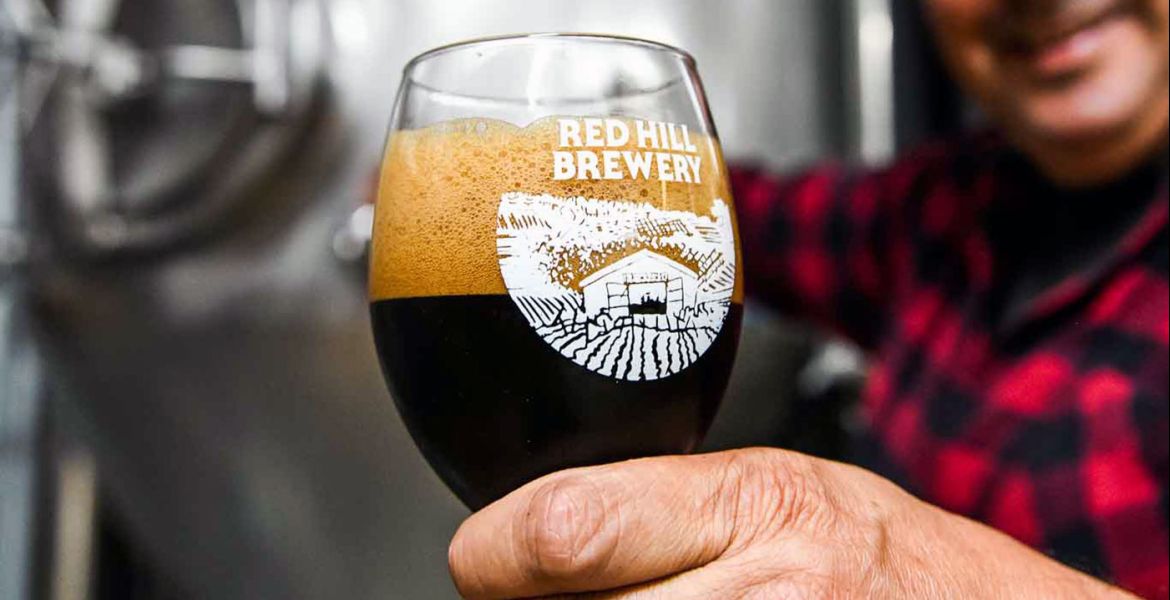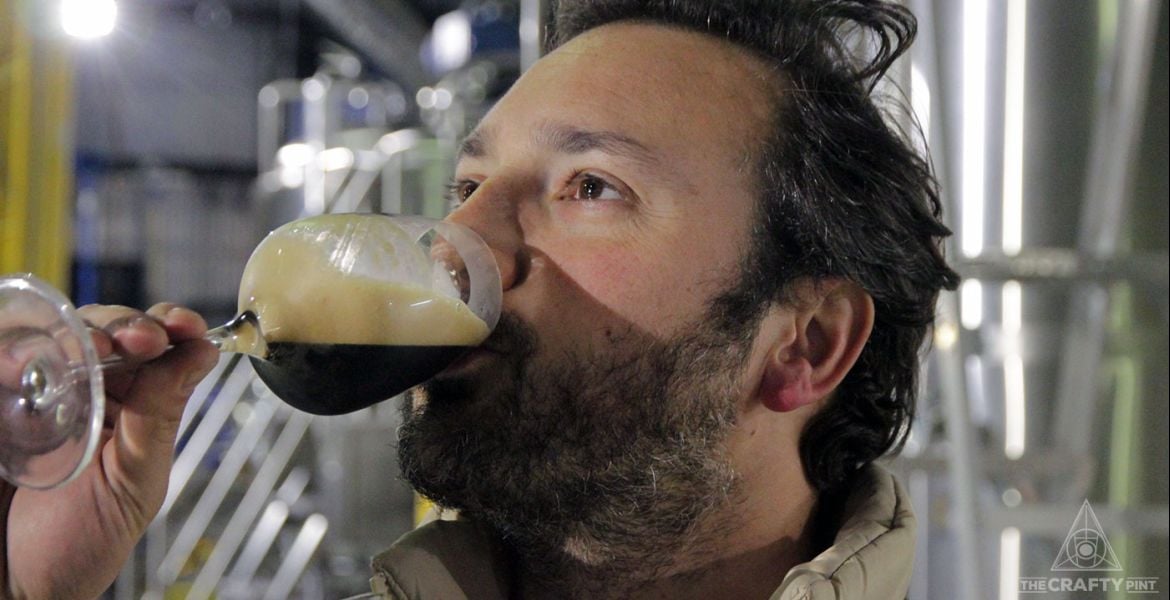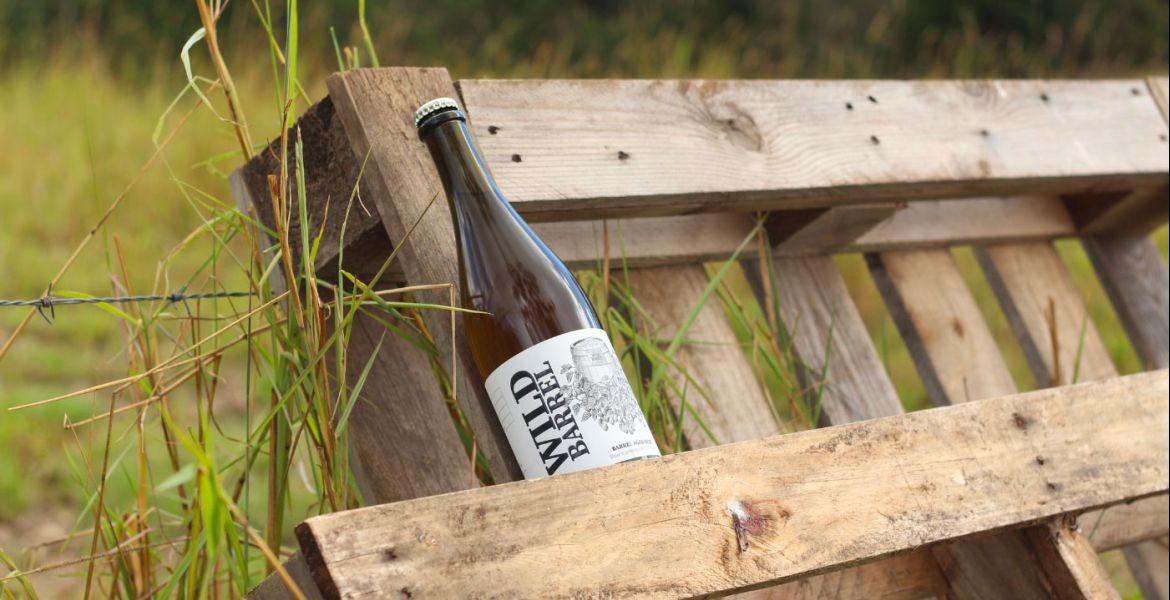Barrel-aged beers are a common sight during winter. Increasingly, you'll find them celebrated in boilermaker pairings too. And yet, despite their relative ubiquity, the Wolf of the Willows Barrel Exchange Project – one centred around barrel-ageing and pairing beer with whisky – manages to stand out from the crowd.
The cross-industry collaboration kicked off in 2018 when Wolf of the Willows founders Scott and Renae McKinnon travelled to Tasmania to select six Lark whisky barrels in which to age a beer (you can read the origin story here). Those freshly-emptied barrels were sent straight across Bass Strait where a dialled-up version of the brewery's Johnny Smoke Porter, or JSP, was waiting.
Months later, the first Lark Imperial JSP appeared and, once the barrels had emptied of beer, they returned to Lark so the pioneering distillery could finish their a whisky in it in order to create the Wolf Release. It's a process that's been repeated every year since and has spawned a sibling too: for the last three years, Wolf of the Willows have released the rye whiskey barrel-aged Persistence in cahoots with The Gospel.
These days, they use rather more barrels than in 2018, but Scott says the close-knit nature of the collaboration remains, with the opportunity to pick the brains of the distillers a highlight for him and his brewers.
“Those personal relationships have been the cornerstone of it and, as Lark have grown, they’ve really valued keeping that connection,” he told The Crafty Pint.
When they started the project, they always aimed to show how closely related craft beer and whisky are; the hope was that the two releases would help break down any barriers between fans of both.
“Cross-industry collaboration is, number one, good fun,” Scott says. “Number two, it creates really cool products. But also, consumers really want to see it and there’s a market for it.”

As they hit the half decade of twin releases this winter, they wanted to give fans the chance not only to try Lark Imperial JSP and the Wolf Release side by side but also to take a dive into their history. As such, a launch event at their Mordialloc taproom will feature versions III, IV and V, while Beer DeLuxe and Naughtons Hotel are hosting intimate food pairing events too.
“There are all these people that look forward to it, savour it, and love its history,” Scott says. “This year, we’ve really tried to show respect to that so we’re getting some of those releases we’ve hoarded and giving people the chance to explore and contrast them.
“We want to give it that opportunity to shine and, even in this day and age, it’s an unusual product being a barrel-aged smoked porter.”
He says the beer-finished whisky is a favourite of Lark head distiller Chris Thomson, while demand for the whisky has been outstripping what they produce each year. So, ahead of their forthcoming launch, we invited Scott to tell us all about the beer and its history as part of our occasional The Story Of... series.
Lark Imperial JSP
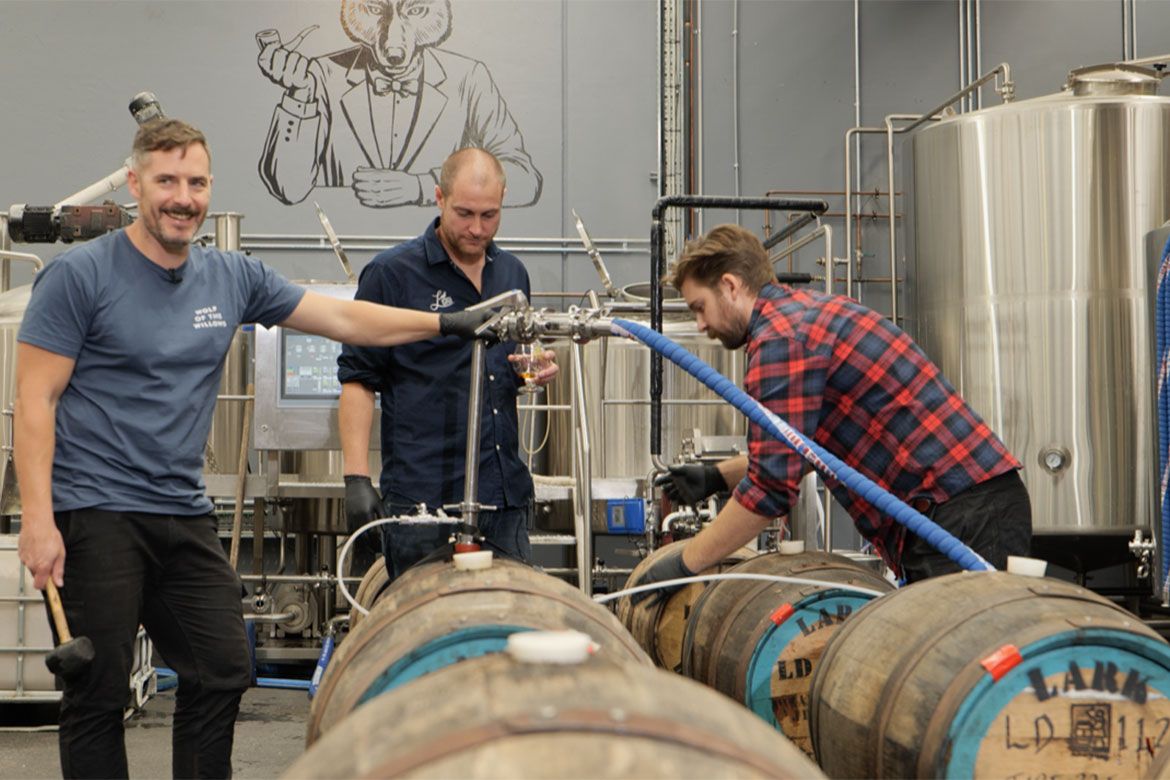
When was the beer conceived and why did you want to work with Lark on it?
Where all good ideas come from – over a beer in a pub. It was at The Local Taphouse where Craig Johnstone, who worked in production at Lark, and I first met, chatted for a few hours over a few beers and drams, and then almost stumbled across the synergies between what we love and what inspires us. A few emails, phone chats and some tastings later saw the first collab born – Raisin’ Kilts – a rum and raisin rum barrel-aged scotch ale for GABS 2017. Brew days in full Scottish kilts led to a partnership being formed.
From this beer, the friendships grew, with more dialogue between Lark and ourselves, and it is here the creative processes really kicked in. A few months later, Renae and I made a trip Tassie where many barrels were tasted, numerous brewer and distiller discussions occurred, and just enough late night karaoke took place. That was when we created this thing called the Barrel Exchange Project, with the imperial JSP and the Wolf Release being the first love child of the concept.
Lark Distillery is the Tasmanian Distillery. Without Lark, the Australian craft distilling landscape would look very different. Bill Lark literally lobbied the government to change legislation to legally allow distilling and hand-shovelled peat from Tasmanian peat bogs to first create "Tasmanian Whisky", with Tasmania now being an internationally recognised whisky region.
This legacy of innovation, hard work, and doing it all in a collaborative manner is still exemplified by the incredible crew at Lark today. We have an incredible respect for Lark and are honoured to partner with them.
What did you hope to achieve with the Barrel Exchange Project?
The aim was to bring distillers and brewers together, to share ideas, to share barrels and to try to create the "Ultimate Boilermaker" that was greater than just beer and spirits aged in these barrels. Taking the classic elements of contrast and complement, the selection of the individual barrels, the whisky characteristics from these barrels, and the malt profile of the beer are all sculptured to have a unique symbiosis of sensory characteristics.
In craft beer circles the concept of ageing beer is not a new phenomenon. However, we wished to take this to a new level where the dialogue between brewer and distiller was in such synergy that the end products of the beer and whisky went above and beyond post-production beer and whisky matching.
Was it inspired by any beer in particular you’d tried here or overseas?
Locally, the Ramjet series from Boatrocker has been a massive inspiration. Matt, Andrea and the crew create barrel-aged beers that have laid the barrel-ageing foundations for Australian brewers. Internationally, Russian River's abstract and innovative use of wine barrels from their local Sonoma region to age beers has been an inspiration of our brewing journey from before we even thought of launching Wolf.
We wanted to create a beer that took creative inspiration from the abstract innovation of the brewers noted above – and too many more to mention – without simply copying what they had done, hence using an imperial smoked porter as the canvas. As far as we were aware, back in 2017 no one had created a whisky barrel-aged imperial smoked porter.
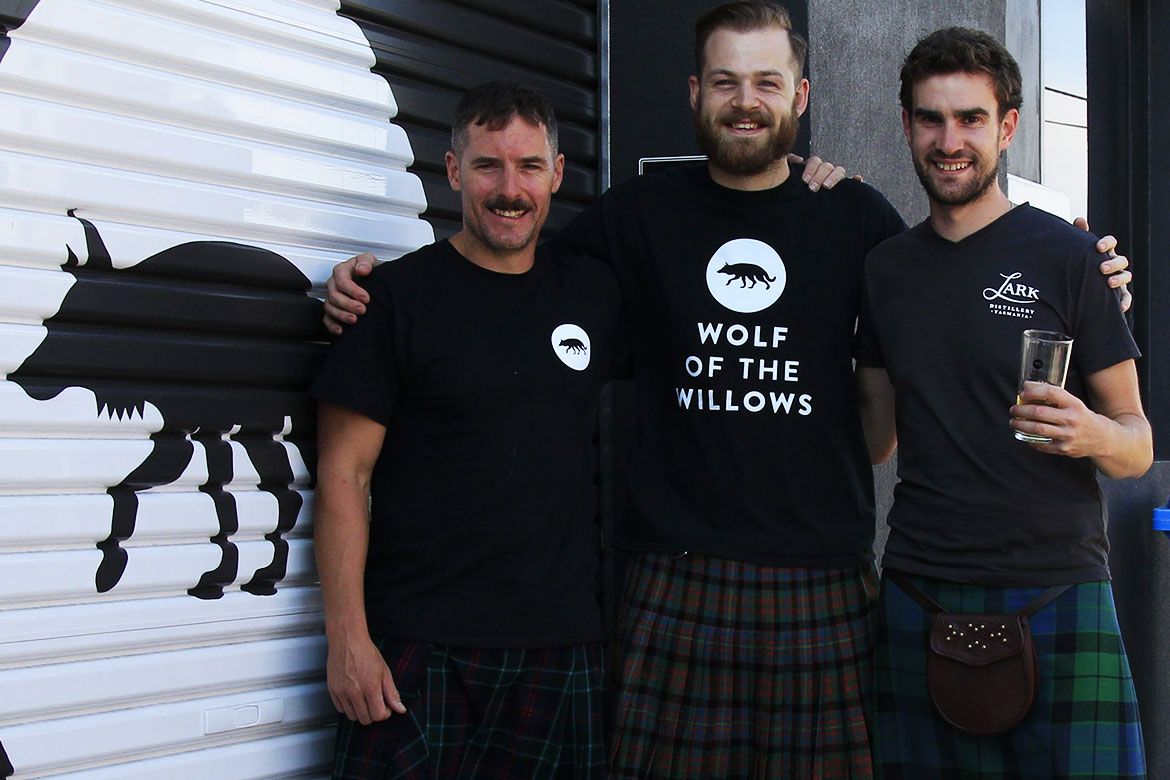
Does the beer change each year, or do you try to keep it as close as possible to what’s come before?
The beer recipe has evolved through the years based on changes in the whisky and whisky barrels available, predominately around the type and volume of smoked malt. We are always striving for improvement in every area and our Imperial JSP is no different. In recent years the underlying recipe has become more consistent based on in depth sensory evaluation in the early years. However, if we feel a minor change to malt, bitterness or time in barrel will improve the beer, then we are happy to make that change.
Starting and finishing gravities have also varied based on seeking different mouthfeel from different vintages, also leading to changes in alcohol content.
Very importantly, whisky, oak characteristics, and tannin extraction from the barrels have varied significantly, mainly based on the type, size, age and the whisky style that previously was aged in the barrels. Interestingly, the atmospheric characteristics – as in the impact of the weather and whether it's hot, colder or the humidity, where the barrels with beer in them have been aged – have also heavily influenced the beer. Even the height within the brewery where each barrel is stored will have an influence on the beer in that particular barrel.
Are there any releases that have stood out to you?
Every year, we evaluate and analyse each release vintage, as well as back vintages that have had time to age even more. We want to create beers that continue to evolve and gain depth of flavour over the years, even post coming out of the barrel.
Based on this we are constantly improving our recipes and process, so feel the beer recipe improves year on year, offering something different each vintage. Balance is probably the key to that. This year’s is one we are really excited about, with the balance of smoke, whisky and other flavours really working in harmony straight out of the barrel.
For the back vintages, the 2021 has been a real standout as it has aged in keg/can, with the luscious oak mouthfeel and marriage of aged smoked malt and Tassie whisky being highlights. We’re actually releasing a limited number of these kegs and cans again so we can share how this beer has aged with the world.
Similarly, Lark is also bringing a small quantity of their 2021 Wolf Release IV out of storage and offering for sale to coincide with the 2022 release. Just quietly, this is head distiller Chris Thomson’s personal favourite whisky ever released by Lark.
What’s the process that goes into making it each year? And how long before its release are you working on it?
We use a process called re-iterated mashing to brew the Imperial JSP. This involves taking the second wort runnings of the lauter and using this liquid to mash in the next brew. This ensures we utilise all the sugars in the grain, helping us hit high gravity and alcohol and also helps extract all those big flavours we are after. These brew days can be long, and we need to take special care of temperatures and pH throughout the whole process.
After the beer has fermented and matured for a period in tank, we transfer to freshly-emptied Lark Whisky barrels where it will spend between six to nine months. We are brewing the first half of next year's release in the same week we are releasing this year’s – so 12 months prior to release. Early next year, we will empty the barrels and store the beer for blending. Those barrels will then return to Lark where they will be used for whisky. Fresh barrels will be sent back our way and we will brew the second half of the batch to fill these with. This second batch will then spend six months in barrel before final blending and packaging.
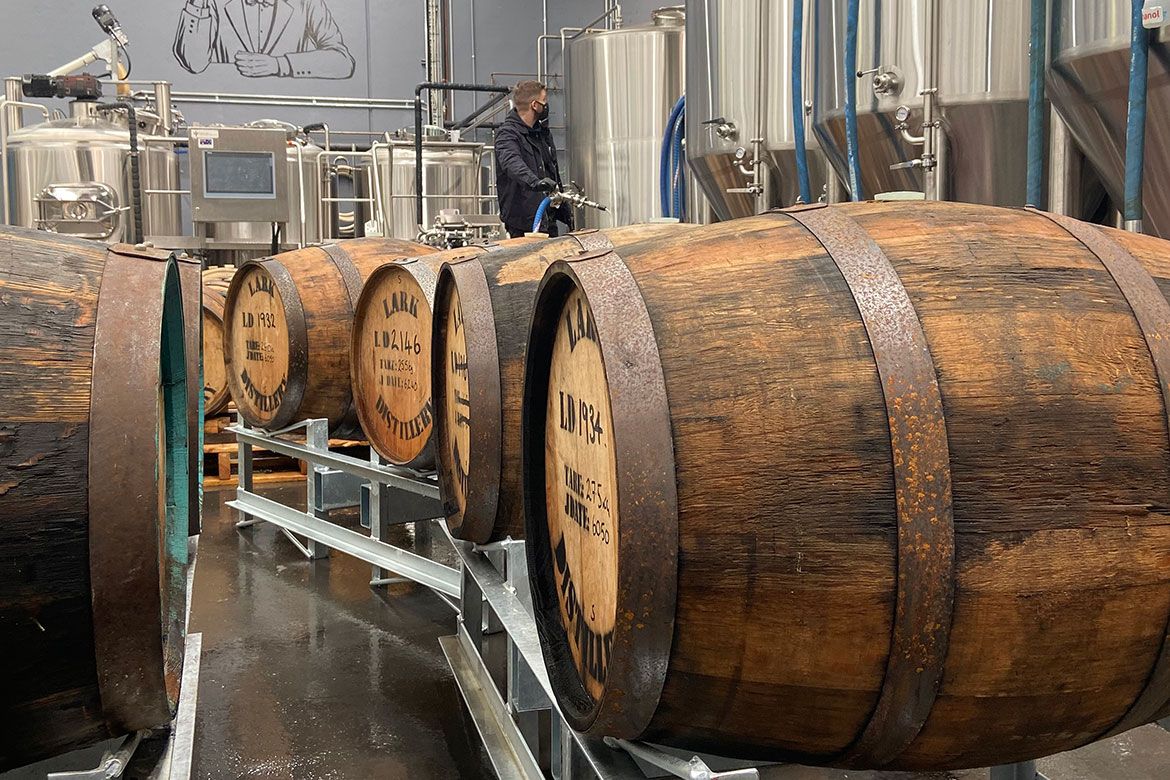
How do you go about selecting Lark barrels? Are you looking for certain characteristics?
In the early days of Imperial JSP’s inception, we hand-selected barrels based on the character they were lending the whisky inside. Back then it was only six barrels. These days we’re going through up to 60 barrels and we mutually agree with the team at Lark on what characteristics we will aim for in each vintage. We trust the expert team at Lark to then give us ones that are full of character and of the highest integrity – and they always are.
When we receive the barrels they are freshly emptied and still soaked with whisky. This not only imparts deep flavours into the beer but also ensures they maintain sterility and moisture.
Tell us about the Lark whiskies that have been finished on the barrels you’ve sent back. What kind of feedback have you received on them from the distillery and wider whisky market?
According to Chris, the Wolf Release is one of Lark’s most anticipated and highly-regarded whiskies each year. Simply it is a whisky like no other on the market. The 2022 whisky is like soft pineapple lollies mixed with milk chocolate with a hint of smoke... but as a whisky!
You’ve worked closely with other distilleries too; how do you pick who to work with, and is the barrel selection process with the likes of The Gospel similar to working with Lark?
It all comes down to the people we respect and who we enjoy working with. We view collaborations as a way to expand our knowledge and have fun whilst doing it. Barrel selection always involves a vision for what we’re trying to achieve with the beer along with an understanding of the nuances of the barrels, which requires the distiller's guidance.
How big is your barrel program now?
We started with just six barrels and now we’re using 50 to 60 barrels from Lark alone. We also have a dozen barrels from Gospel and a handful of ex-wine barrels for other experimental beers.
What’s in store for Lark V?
We are really excited for its release. It's rich in whisky, dark cocoa, espresso, truffle, vanilla, molasses and an underlying smoke, while maintaining great balance. We’re excited to have a number of events around Melbourne for its launch. Some venues will be serving up vertical tasting of Imperial JSP V and some previous vintages.
You can find details of the launch events above or in the Crafty Events Diary. And you can try to get your hands on a one-off prize pack worth $500 that's been put together exclusively for readers of The Crafty Pint.
To be in the running, all you need to do is sign up to receive The Crafty Pint's newsletters via the form below before 5pm AEST on August 15, 2022 – full details here. We'll then pick a winner at random and notify them via email. View our competition rules here.
WIN A WOLF LARK PACK
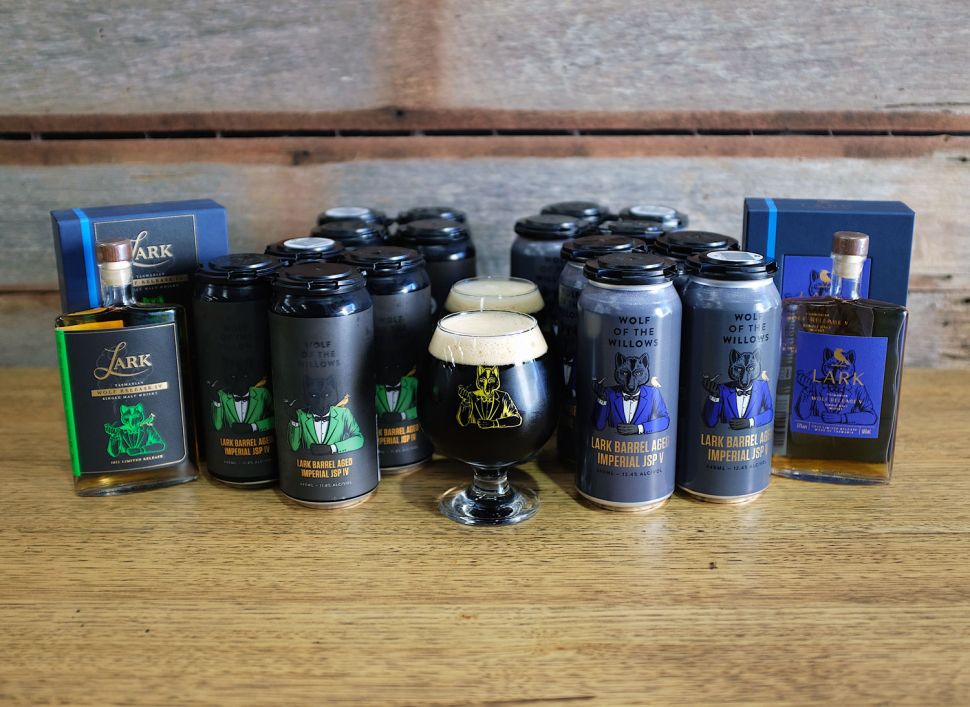
By entering this competition, you agree to receive email newsletters from The Crafty Pint.
If you're already on our mailing list, you can still enter.




